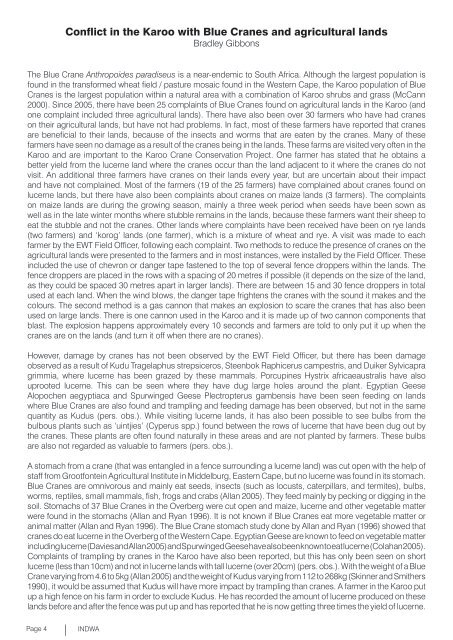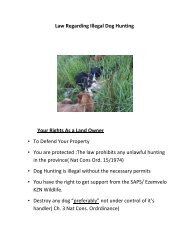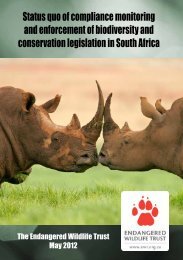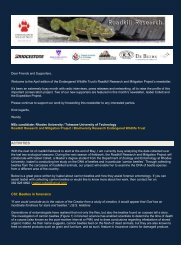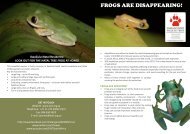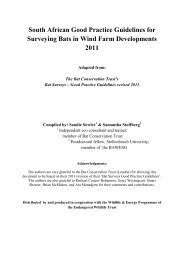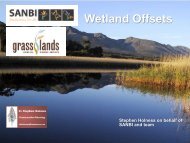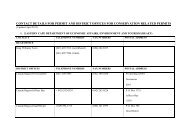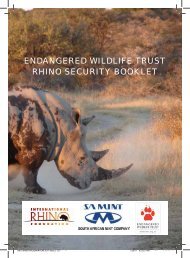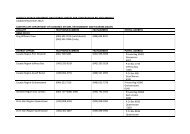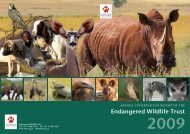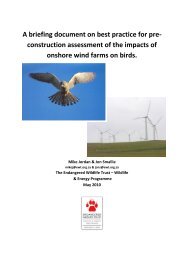No 8 - Endangered Wildlife Trust
No 8 - Endangered Wildlife Trust
No 8 - Endangered Wildlife Trust
Create successful ePaper yourself
Turn your PDF publications into a flip-book with our unique Google optimized e-Paper software.
Page 4<br />
Conflict in the Karoo with Blue Cranes and agricultural lands<br />
Bradley Gibbons<br />
The Blue Crane Anthropoides paradiseus is a near-endemic to South Africa. Although the largest population is<br />
found in the transformed wheat field / pasture mosaic found in the Western Cape, the Karoo population of Blue<br />
Cranes is the largest population within a natural area with a combination of Karoo shrubs and grass (McCann<br />
2000). Since 2005, there have been 25 complaints of Blue Cranes found on agricultural lands in the Karoo (and<br />
one complaint included three agricultural lands). There have also been over 30 farmers who have had cranes<br />
on their agricultural lands, but have not had problems. In fact, most of these farmers have reported that cranes<br />
are beneficial to their lands, because of the insects and worms that are eaten by the cranes. Many of these<br />
farmers have seen no damage as a result of the cranes being in the lands. These farms are visited very often in the<br />
Karoo and are important to the Karoo Crane Conservation Project. One farmer has stated that he obtains a<br />
better yield from the lucerne land where the cranes occur than the land adjacent to it where the cranes do not<br />
visit. An additional three farmers have cranes on their lands every year, but are uncertain about their impact<br />
and have not complained. Most of the farmers (19 of the 25 farmers) have complained about cranes found on<br />
lucerne lands, but there have also been complaints about cranes on maize lands (3 farmers). The complaints<br />
on maize lands are during the growing season, mainly a three week period when seeds have been sown as<br />
well as in the late winter months where stubble remains in the lands, because these farmers want their sheep to<br />
eat the stubble and not the cranes. Other lands where complaints have been received have been on rye lands<br />
(two farmers) and ‘korog’ lands (one farmer), which is a mixture of wheat and rye. A visit was made to each<br />
farmer by the EWT Field Officer, following each complaint. Two methods to reduce the presence of cranes on the<br />
agricultural lands were presented to the farmers and in most instances, were installed by the Field Officer. These<br />
included the use of chevron or danger tape fastened to the top of several fence droppers within the lands. The<br />
fence droppers are placed in the rows with a spacing of 20 metres if possible (it depends on the size of the land,<br />
as they could be spaced 30 metres apart in larger lands). There are between 15 and 30 fence droppers in total<br />
used at each land. When the wind blows, the danger tape frightens the cranes with the sound it makes and the<br />
colours. The second method is a gas cannon that makes an explosion to scare the cranes that has also been<br />
used on large lands. There is one cannon used in the Karoo and it is made up of two cannon components that<br />
blast. The explosion happens approximately every 10 seconds and farmers are told to only put it up when the<br />
cranes are on the lands (and turn it off when there are no cranes).<br />
However, damage by cranes has not been observed by the EWT Field Officer, but there has been damage<br />
observed as a result of Kudu Tragelaphus strepsiceros, Steenbok Raphicerus campestris, and Duiker Sylvicapra<br />
grimmia, where lucerne has been grazed by these mammals. Porcupines Hystrix africaeaustralis have also<br />
uprooted lucerne. This can be seen where they have dug large holes around the plant. Egyptian Geese<br />
Alopochen aegyptiaca and Spurwinged Geese Plectropterus gambensis have been seen feeding on lands<br />
where Blue Cranes are also found and trampling and feeding damage has been observed, but not in the same<br />
quantity as Kudus (pers. obs.). While visiting lucerne lands, it has also been possible to see bulbs from the<br />
bulbous plants such as ‘uintjies’ (Cyperus spp.) found between the rows of lucerne that have been dug out by<br />
the cranes. These plants are often found naturally in these areas and are not planted by farmers. These bulbs<br />
are also not regarded as valuable to farmers (pers. obs.).<br />
A stomach from a crane (that was entangled in a fence surrounding a lucerne land) was cut open with the help of<br />
staff from Grootfontein Agricultural Institute in Middelburg, Eastern Cape, but no lucerne was found in its stomach.<br />
Blue Cranes are omnivorous and mainly eat seeds, insects (such as locusts, caterpillars, and termites), bulbs,<br />
worms, reptiles, small mammals, fish, frogs and crabs (Allan 2005). They feed mainly by pecking or digging in the<br />
soil. Stomachs of 37 Blue Cranes in the Overberg were cut open and maize, lucerne and other vegetable matter<br />
were found in the stomachs (Allan and Ryan 1996). It is not known if Blue Cranes eat more vegetable matter or<br />
animal matter (Allan and Ryan 1996). The Blue Crane stomach study done by Allan and Ryan (1996) showed that<br />
cranes do eat lucerne in the Overberg of the Western Cape. Egyptian Geese are known to feed on vegetable matter<br />
including lucerne (Davies and Allan 2005) and Spurwinged Geese have also been known to eat lucerne (Colahan 2005).<br />
Complaints of trampling by cranes in the Karoo have also been reported, but this has only been seen on short<br />
lucerne (less than 10cm) and not in lucerne lands with tall lucerne (over 20cm) (pers. obs.). With the weight of a Blue<br />
Crane varying from 4.6 to 5kg (Allan 2005) and the weight of Kudus varying from 112 to 268kg (Skinner and Smithers<br />
1990), it would be assumed that Kudus will have more impact by trampling than cranes. A farmer in the Karoo put<br />
up a high fence on his farm in order to exclude Kudus. He has recorded the amount of lucerne produced on these<br />
lands before and after the fence was put up and has reported that he is now getting three times the yield of lucerne.<br />
INDWA


